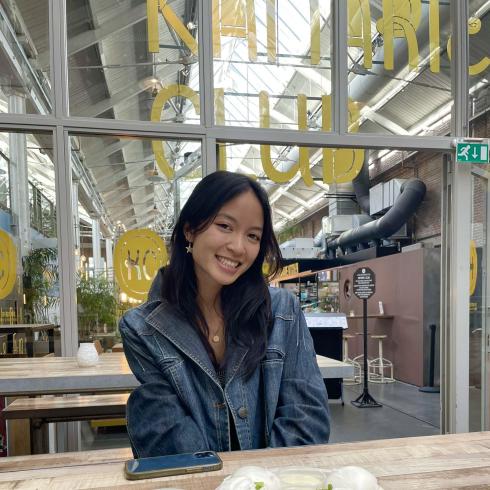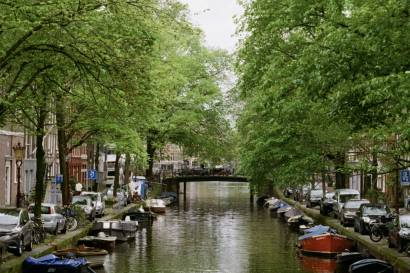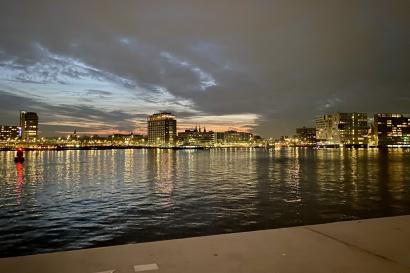
I did end up going to the Sinterklaas parade. That Saturday morning, November 13th, I did some catchup work at Coffee Company on Kinkerstraat (recently my go-to study spot, ideal for being productive and people-watching) then biked to Leidsplein, the final destination for the Christmas procession. There was a giant stage and framework for spotlights set up in front of the Internationaal Theater. People in blue jackets and neon reflector vests were stationed around the blocked off road, and already, almost two hours before Sinterklaas was to arrive at the theater, families were gathering around the blockades, reserving their spot. Children dressed as Sinterklaas’ helpers were running around in the bright sunshine. Their costumes weren’t “elves” per-say, but more quaint, something out of a fairy tale; gold rimmed vests over frilly white button ups, richly colored balloon pants, high stockings, and a matching cap typically with one feather. Of the handful of kids I saw waiting around Leidseplein, maybe half of them had “soot” smeared on their rosy cheeks, chins, and foreheads; faint, but apparent. I was put off but didn’t know what to think of it. A small part of me was sympathetic to the fact that they were children trying to enjoy the holiday the only way they knew, by dressing up as the holiday caricature designed specifically for them. Mostly, though, I was simply wondering, why even bother? Why even try to imply that it is “from chimney soot” or that the character is only being mischievous towards the children? Even that in itself raises criticisms for me. Why not get rid of that aspect of the character altogether? The line between right and wrong didn’t seem so arbitrary to me, an American who firmly knows the racist implications of blackface. But I understood that I was not Dutch, didn’t experience this character in my childhood, nor do I have any cultural traditions through which I could relate to the people who grew up with Zwarte Piet.
Sinterklaas was supposed to arrive at Leidseplein around 3:00 p.m., but I didn’t want to wait so I parked my bike at Leidseplein and followed the route down Weteringschans towards Vijzelgracht. Every other block, I saw more people in blue jackets and vests, sitting around waiting for the man with the big white beard. Most of them looked my age or younger, snacking on croissants out of Albert Heijn bags, so I presumed they were volunteers. As I approached the giant roundabout of trams at Vijzelgracht, I saw a colorful crowd of tiny Sinterklaas helpers and their parents lining the road. The area was packed; kids darting in and out of the barricades, parade security perusing up and down, looking self-important, tourists and locals alike shuffling for space, and commutters just trying to get past. I ended up finding space for one person next to two students my age and a family from the UK. I couldn’t help but notice the children who had traces of soot on their faces. Every one of them was between the ages of three and six; up front, the soot on the face seemed innocent. As I stood waiting, a few kids started dancing in the empty street. Their celebratory spirit and bravery inspired more Sinterklaas helpers to duck out from under their parents’ wing and form their own parade down the road; marching, running, dancing, and cartwheeling gleefully in the holiday spirit. They provided entertainment for a good twenty minutes before security began to wave them back. Two police cars slowly rolled through before everyone finally caught a glimpse of the Christmas procession.
I assumed at first glance that the decked out, old-fashioned trolley car that rolled along the tram tracks was carrying Sinterklaas himself. Instead, elaborately costumed Sinterklaas helpers leaned out of the car, handing out candy and kruidnoten, tiny gingerbread-esque cookies. About half as many cookies and candies ended up littering the ground as those that made it into the tiny outstretched hands. The end of the trolley car revealed more helpers dancing in lines, singing and tossing sweets at the kids. Younger volunteers, probably only a few years younger than me, ran here and there, feigning mischief by sneaking cookies into the boots, hoods, and hats of distracted kids, who exclaimed happily upon realization. One Sinterklaas helper had a net attached to the end of a long pole, like an extreme lacrosse stick, which she used to deposit kruidnoten to a little boy whose dad had lifted him onto his shoulders. Everyone cheered as the boy rejoiced with his fistful of cookies and the volunteer continued to refill her net and skip along. Men in smart white button ups and black velvet vests strode forward, slowly waving large yellow flags adorned in some Dutch saying and fancy black crests. Several marching bands paraded through, followed by a truck and trailer on which four girls in costume sang what I presumed was a Dutch Christmas carol into a microphone, prompting the Dutch families around me to take up the song as they went by. And always, there seemed to be an endless amount of Sinterklaas helpers, anywhere from the ages of sixty to sixteen, all with smeared black faces but never full coverage, moving in and out of the procession, from one side of the path to the other, bringing smiles to the faces of kids, encouraging even the parents to accept some kruidnoten. Finally, another line of security plodded forward and behind them, Sinterklaas in all his saintly glory on the back of a giant white horse. He wore the patronly white robes and stole of a bishop , topped off with a red mitre adorned with a golden cross design. His red cape was draped down the back of the saddle, and his curly white beard was tiered like a wedding cake. After doing research, I found out Sinterklaas is always supposed to arrive on the back of a white horse, which I found very classy, and fitting since he was literally Saint Nicholas. I wondered where in the world did America get the idea that Santa requires a sleigh and reindeer. Sinterklaas waved down from his steed, showing equal adoration for all his miniature fans, and the parade closed out with the final march of Sinterklaas helpers on horseback, kids reaching out to brush the flanks of the horses.
The Dutch Sinterklaas was so far from the American Santa Claus who sits in malls under a taller than a house Christmas tree, granting wishes and posing for pictures. For the record, I was never one to ask my parents to see mall Santa (he scared me). I also didn’t stay to see Sinterklaas arrive in Leidseplein, so maybe he ended up doing a similar thing for the Dutch children I’d seen earlier anxiously waiting. Once the parade passed through Vizjelgracht, the crowd dispersed, half following Saint Nicholas, the other half bundling their jackets and finding their way back to their cars and bikes. The sun was already dropping in the sky, enhancing the wintery chill that crept in while I was standing around. Watching kids and their families sharing the candies and kruidnoten, I wondered what it would be like to grow up knowing Santa Claus as Saint Nicholas and thinking nothing of his Dutch helpers who dashed about with black faces. I wondered what it was like for Dutch parents, who probably grew up with the same caricature to a different degree, but were now more likely to be aware of the racist implications and have to explain it to their little wannabe chimney climbing helpers. Right? I wondered what that conversation was like, or how often it happened that morning, or the night before, in Dutch households, or if at all. I was relieved I didn’t see anyone with an explicit black face (I had definitely braced myself for it) but walking away, I had unidentifiable, mixed feelings, bringing me back to the same question as before, Why even bother with the chimney story coverup? Why even bother at all? I was puzzled how the Zwarte Piet tradition could persist so insistently in the Netherlands, given the abundance of racism discourses that circle and try to snuff it out. Part of me was hoping there would be protestors, that I would be able to witness in real time the outrage and counter arguments with which I completely agree and I’d come away equally upset. Instead, I left with so much more to think about.

Emma Basco
My name is Emma Basco and I am originally from Sacramento, California. I am currently studying literature and writing at Sarah Lawrence College in New York. I love to read on the beach, doodle on post it notes, paint with watercolors, and unearth new cafes and restaurants. My hidden talent is that I can make an excellent pot of noodles from packaged ramen.






